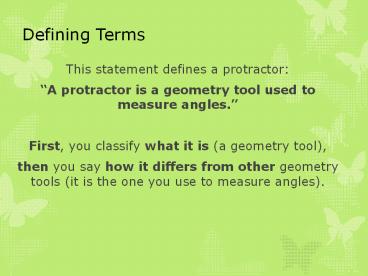Defining Terms - PowerPoint PPT Presentation
Title:
Defining Terms
Description:
Defining Terms This statement defines a protractor: A protractor is a geometry tool used to measure angles. First, you classify what it is (a geometry tool), – PowerPoint PPT presentation
Number of Views:93
Avg rating:3.0/5.0
Title: Defining Terms
1
Defining Terms
- This statement defines a protractor
- A protractor is a geometry tool used to measure
angles. - First, you classify what it is (a geometry tool),
- then you say how it differs from other geometry
tools (it is the one you use to measure angles).
2
Parallel Lines
Notation h // g Definitions Parallel lines
are coplanar lines that do not intersect. Skew
lines are non-coplanar lines that do not
intersect
Picture markings for parallel lines
Line a is skew to line b
3
Perpendicular Lines
l
k
- Definition
- Perpendicular lines are intersecting lines that
form 90 angles.
4
- 7 Angle relationships to define
- Right angle
- Acute angle
- Obtuse angle
- Complementary angles
- Supplementary angles
- Linear pair of angles
- Vertical angles
5
Textbook Investigation Lesson 1.3
http//acr.kendallhunt.com/KeyPressPortalV5.0/View
er/HomeFrame.htm
6
Types of Angles
- An Acute angle is an angle that measures between
- 0 and 90
- A Right angle is an angle that has a measure of
90 - An Obtuse angle is an angle that measures between
- 90 and 180
7
Complementary Angles Complementary angles are
two angles whose sum of their degree measurements
equals 90 degrees. Example These two angles
are complementary. Their sum is 90.
58 32 90
8
Adjacent Complementary Angles.
Those same two angles can be "pasted" together to
form a right angle! These 2 angles are adjacent
they share a vertex and a side.
9
Supplementary Angles Supplementary angles are
two angles whose sum of their degree measurements
equals 180 degrees. Example These two angles
are supplementary. The sum of their measures is
180
139 41
180
10
Linear Pair of Angles Adjacent Supplementary
Angles
A linear pair of angles are two angles that are
adjacent and supplementary angles.
11
Linear Pair of angles
A linear pair of angles are two angles that are
adjacent and supplementary angles.
Conjecture If two angles form a linear
pair, then they are supplementary.
12
Vertical Angles Vertical angles are opposite
angles formed by intersecting lines. For
any two lines that meet, as in the diagram below,
ltAEB and ltDEC are called vertical angles. ltBEC
and ltAED are also vertical angles.
110
70
70
110
13
Vertical Pair of Angles
Vertical angles are two angles that are created
by two intersecting lines and are opposite each
other.
lt 1 lt3 are a vertical pair of angles lt 2 lt4
are a vertical pair of angles
Conjecture If two angles are vertical
angles, then they are congruent.
14
Angles Around a Point Angles around a point will
always add up to 360 degrees.
The angles above all add to 360 53 80
140 87 360
15
We can find an unknown angle using this sum.
Example What is angle C"?
To find the measure of lt C, find the sum of the
known angles and subtract that from 360 .
C
Sum of known angles 110 75 50 63
298
mlt C 360 - 298 m lt C 62
16
(No Transcript)
17
Review
State whether the following are acute, right, or
obtuse.
1.
3.
5.
2.
4.
?
?
18
Complementary and Supplementary
Find the missing angle.
- Two angles are complementary.
- One measures 65 degrees.
- Two angles are supplementary.
- One measures 140 degrees.
19
Complementary and Supplementary
Find the missing angle. You do not need a
protractor. Use the clues in the pictures.
9.
8.
x
x
165
55
20
Vertical Angles Linear Pair
10. Find the missing angles. You do not need a
protractor. Use the clues in the pictures.
y
x
58
21
More drawings
11. Find the measure of all the angles with
vertex C
E
F
Box in the corner indicates a right angle.
D
C
G
J
H
22
Final Drawing12. Find the measure of all the
angles with vertex G.
B
C
G
D
A
E
F
23
(No Transcript)































